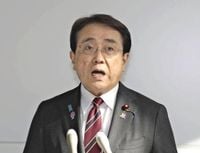As Japan navigates the complexities of international trade relations under the Trump administration, the echoes of past economic upheavals resonate strongly, particularly the Nixon Shock of 1971. This historical parallel was drawn by Ryosei Akazawa, Japan's economic revitalization minister, who spoke to the media at Haneda Airport on April 18, 2025, after returning from discussions in the United States. Akazawa's comments reflect a growing concern among Japanese officials about the shifting dynamics of global trade and the implications for Japan's economy.
President Donald Trump’s aggressive trade policies have stirred significant debate, reminiscent of the Nixon administration's drastic measures to stabilize the U.S. economy. In 1971, President Richard Nixon suspended the dollar's convertibility into gold, a pivotal moment that marked the beginning of the end for the Bretton Woods system. This agreement, established in 1944, had fixed exchange rates and positioned the dollar as the world’s reserve currency, stabilizing the post-World War II global economy.
Fast forward to today, and Trump appears intent on rewriting the rules of international trade, a move that could reshape the global economic landscape once again. Akazawa noted the stark differences between the economic contexts of Nixon and Trump. While Nixon faced a struggling U.S. economy burdened by the costs of the Vietnam War, Trump leads a nation that remains the sole superpower in the global economy.
The Nixon Shock led to the abandonment of fixed exchange rates and the transition to a floating exchange rate system, a change that was solidified in early 1973. Countries began to recognize the limitations of fixed rates as the dollar crisis deepened. As Akazawa reflects on these historical lessons, he emphasizes that Japan must adapt its strategies to navigate this new era of potential trade conflicts.
During a meeting on April 16, Trump expressed dissatisfaction with the lack of American cars on Japanese roads, a comment that underscores the ongoing trade tensions. This sentiment resonates with past sentiments expressed during the Nixon administration when Japan was pressured to raise the value of its currency. In a diplomatic document dated February 6, 1973, Nixon’s tough stance towards Japan was evident as he demanded currency adjustments, dismissing Japanese concerns with a blunt remark: "The Japanese sensitivities — to hell with them. Let’s go right ahead."
Today, Japan is grappling with its position in a trade landscape that has shifted dramatically since the 1990s. Once a dominant player in the U.S. trade deficit, Japan's share has now dwindled to less than 10%, with China emerging as the largest contributor to the deficit, accounting for a quarter of the total. This shift highlights the changing dynamics of global trade, where Japan must now find its footing amidst rising tensions with China and evolving U.S. policies.
In light of these developments, Japan is exploring ways to bolster its agricultural imports from the United States. Liberal Democratic Party Secretary-General Moriyama Hiroshi indicated that Japan is considering increasing imports of U.S. soybeans and corn as part of the ongoing trade discussions. Moriyama stated, "Buying more U.S. corn would not be a problem," noting that most imports already come from the U.S. and Brazil. This move could help mitigate some of the impacts of the ongoing trade friction between the U.S. and China, which has led to a decline in U.S. soybean exports to China.
However, there are concerns about the potential repercussions of importing more American rice, with some officials cautioning that it could adversely affect Japan's domestic agricultural industry. As Japan contemplates these trade negotiations, the historical context of the Nixon Shock serves as a reminder of the potential consequences of aggressive trade policies.
Trump's administration has also proposed a new framework for international trade that echoes the Plaza Accord of 1985, suggesting that countries should work together to address the strong dollar's impact on U.S. exports. This proposed “Mar-a-Lago Accord” aims to have other countries purchase long-term U.S. Treasury bonds to mitigate interest rate risks, a strategy that may not be easily accepted by all nations, particularly China and Europe.
As Japan engages in these discussions, the stakes are high. The outcome of the Japan-U.S. tariff negotiations will be a critical test of Trump’s intentions to reshape the future international order. The historical parallels drawn between Nixon and Trump highlight the potential for significant shifts in trade dynamics, with Japan needing to adapt to an increasingly complex global landscape.
In conclusion, as Japan seeks to navigate these turbulent waters, the lessons of the past become ever more relevant. The interplay of historical context, economic strategy, and international relations will shape the future of Japan-U.S. trade. The ability of Japan to effectively negotiate its interests while addressing the pressures from the U.S. will be crucial in determining the trajectory of this vital economic relationship.




